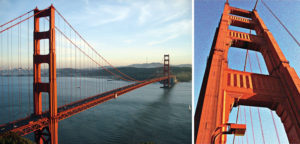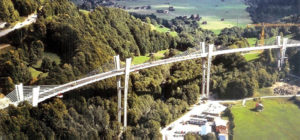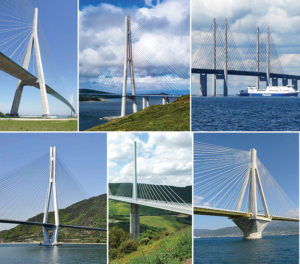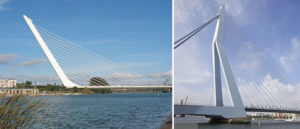The Role of Engineers, Architects, and Builders
Bridges are among the oldest structures used by mankind. From meeting purely utilitarian necessities, bridges have evolved with time to become symbols of human progress, of cities and entire countries. Among the thousands of bridges around us are the bridges that we all admire, the bridges that are the symbols of the eternal human aspiration for building longer and taller, stronger and faster.
When discussing bridges, important issues to consider are aesthetics and the respective roles of engineers, architects, and builders in designing a bridge. What makes a bridge structure elegant and appealing? Do we need to involve architects in the bridge design?
Engineers, Architects, and Builders
The Caravan Bridge, a single arch stone structure in Turkey built around 850 BC, is considered the oldest still functioning bridge. In his Histories, Herodotus reports a bridge on stone piers built in Babylon over a channel of the Euphrates River around 550 BC. He also describes temporary military pontoon bridges constructed by the Persian armies: one on the Ister River (Danube) and two long ones used for crossing the Straits of Hellespont (Dardanelles) during their invasion of ancient Greece around 500 BC and 480 BC, respectively. This is about 2,500 years before Bosphorus Bridge I, the first permanent bridge between two continents, was completed in 1973.
Until the early 19th Century there were no structural bridge engineers and architects. These professions and “titles” simply did not exist at that time. Writers and scholars often refer to architects when describing ancient constructions; however, these “chief builders” practiced the combined tasks of present-day engineers, architects, artists and craftsmen. The tasks were performed by single practitioners who were learning their skills by apprenticeship, following the experience of their predecessors and the “trial-and-error” method. Later, during the Middle Ages, with the building of Gothic cathedrals, the leaders of larger projects were called “master builders.”
Master builders produced remarkable structures over the centuries before the first engineers and architects started receiving a formal education. Later, during the Industrial Revolution, with a need for more construction (bridges and buildings) and the development of engineering knowledge, the functions and duties of a single master builder were separated among architects, engineers, and builders. It was only during the 19th Century that civil engineering and architecture took off as technical professions.
During the “Heroic Age” of bridge engineering, Thomas Telford, Isambard K. Brunel, Robert Stevenson, John, Washington and Emily Roebling, and Alexander Gustave Eiffel built astonishing bridge structures. To this day, we still admire and consider these bridges as part of the highest achievements in engineering. Among these bridge builders, only Washington Roebling and Eiffel had formal engineering education (Eiffel being a chemical engineer). The others were self-taught without a formal education in engineering; the bridge-engineering genius John Roebling had completed his academic training but did not take the final exam. At the time, being able to provide a safe and efficient bridge was valued more than having formal degrees.
The general term “engineer” is used in this article for all structural, bridge, civil or self-educated engineers and builders. All remarkable bridges of the past were designed and built by engineers. There are no reports of architectural involvement (in the current meaning of the term) in their design. Only a few bridges in the past required the skills and knowledge of present day architects: for example, the Venetian Rialto Bridge, the Ponte Vecchio in Florence, and the London Tower Bridge, for the buildings integral to these bridges, or others like Pont Alexandre III in Paris due to their rich ornamentation.
Today many engineers working on bridges believe that, due to their education, experience, and skills, they are able to work alone and do not need architectural involvement in bridge design except for secondary elements like vehicle/pedestrian barriers and light poles. Other engineers do work with architects, or at least consult an architect for their bridge design. Since their structures are mostly exposed, bridges are the most “sincere” constructions. Therefore, the bridge designer must consider aesthetics; he is the one that best knows how to resolve the challenge of balancing the contradicting requirements for robustness and slenderness to obtain security and elegance at the same time. So what is the answer to the initial question “Do we need an architect to design a bridge?”
To respond to this question, it is necessary to look at the specifics of bridge aesthetics. Most bridge professionals agree on the fundamental principle that a bridge has to be robust (strong, stiff, and resilient), functional, efficient and economical, but also that it should be elegant – slender with simple forms and well proportioned. It has to be in harmony with its surrounding environment, and if possible, to embellish its natural site (Figure 1 and 2). Even as early as the Roman period, Vitruvius had formulated three important structural qualities – firmitas, utilitas, venustas – meaning that a structure should be solid/robust, useful and beautiful. In modern times, David Billington has set the core principles of good structural design as efficiency (of materials), economy (of cost and time) and elegance (slenderness, elegance, and good proportions). Since then, some of the most prominent bridge engineers, Fritz Leonhardt, Michel Virlogeux, and Christian Menn, have expressed the same understanding of the essential qualities of bridge design.
Regarding the robustness and functionality of bridges, all bridges shall be designed and built to satisfy their primary function – to transfer pedestrians, vehicles and/or trains from one side of an obstacle to the other side. This means that all bridges must have the necessary strength and stiffness to safely carry the prescribed loads per bridge codes. For this reason, robustness is a must for all bridges and need not be discussed further in this article.
The engineer’s role is to provide an efficient and economic structure, while also trying to make it elegant. The engineer’s task is to select the most appropriate bridge type and the correct parameters for a particular project; the builder can provide significant assistance in this process if involved on time. The architect, while advising the engineer on aesthetics, should avoid recommendations that may significantly increase the cost. While aesthetics is more or less subjective, efficiency and economy can be measured objectively by the cost, main structural materials and construction time with respect to bridge span lengths.
Designing Strong and Elegant Bridges
How can an engineer, with or without help from an architect, deliver an elegant and appealing bridge structure?
There is a consensus among professionals that a well-designed bridge in conformance with the structural “basic principles” usually results in an elegant, well-proportioned and appealing structure without the need for additional ornamentation. A bridge design should also take into consideration the visual exposure and appearance of the structure in relation to its site environment. Based on their exposure and location, bridges are:
- Non-visible structures, usually short span bridges on roads without underpasses, not requiring specific attention to aesthetics;
- Typical short or medium span bridges, requiring regular attention to aesthetics;
- Long-span bridges or bridges with significant exposure, requiring special attention to aesthetics;
- Complex bridges with exposure and long approaches, requiring special attention to aesthetics;
- Some bridges span a river, strait, gorge or ravine directly, often without any approaches. Such locations increase the bridge visibility exposure and are more aesthetically demanding.
The most important part of bridge design is the overall concept for the structure and its elements – the selection of the appropriate structural system for the bridge considering its specific function, site location, and required spans. This concept is always the most important, challenging and creative part of engineering. Economy depends mainly on an efficient design concept. Good design concepts minimize future difficulties both in the design office and on the construction site. While experienced engineers can deliver excellent projects even without an architect, it would be preferable for engineers to work in collaboration with an architect with knowledge and understanding of bridge design and aesthetics. Few engineers have the advantage of both engineering and architectural training, with skills like Santiago Calatrava. Perhaps it is a good idea for engineers to work with an architect on their next bridge project. It is also important for engineers and architects to work closely with the builders, starting in the early phases of design.
An ideal solution for most bridge professionals would be a simple straight-line structure with constant depth and without any supports within the span. However, such a solution is possible only for relatively short spans, as it is limited by the strength of the structural material. The required depth for simple or continuous supported girders, even at medium spans, will make the depth-to-span proportion either inefficient or unattractive, therefore, requiring the use of other static systems with slender superstructures.
Renowned bridge engineers have provided the following recommendations for designing more attractive bridges:
- The bridge should be appealing by itself, in harmony with its environment, scale, and character of the site. When complementing its site environment, a bridge is regarded as a high achievement (Figure 1 and 2);
- A bridge system should be selected considering its surroundings – over a river, over a sea, over a deep canyon, within urban areas, etc.;
- Transition from approaches to main spans should be smooth with appropriate relation between neighboring spans;
- Simple forms expressing the flow of forces should be used, maintaining precise order and unity for the
entire structure; - Slender bridge elements and minimum types of elements should be utilized;
- Fewer and lighter pier-supports should be used for more transparency of the substructure;
- Light and shadow effects may be used to visually enforce the slenderness of the bridge components;
- The design should permit appropriate maintenance during the lifetime of the bridge.
Useful recommendations for bridge design are published in Bridge Aesthetics Sourcebook. Practical Ideas for Short and Medium Span Bridges (TRB, 2009).
The Role of Architects in Bridge Design
An architect can provide essential assistance to engineers on the following parts of a bridge project:
- Selection of the most appropriate structural system and the overall concept for the project;
- Improvement of the proportions of the main bridge components – ratio of depth to span lengths, ratio of central to side spans, providing good order and proportions;
- Form shaping of the main components – piers and superstructure elements; design of the towers and pylons for suspension and cable-stayed bridges – their composition (single, two, three or more columns at one support), shape of the frames, configuration of cable-stays (fan, harp, etc.), general aesthetic advice for the best visual design in cable-stayed bridges;
- Pedestrian bridges, where the relatively shorter spans, combined with higher visibility and lighter loads, provide more opportunities for design creativity;
- Bridges with above-deck structures, regardless of whether they are arch, suspension, or cable-stayed structures, have a significant visual effect on everyone on the bridge deck.
- Secondary elements like vehicle barriers, pedestrian railings, and light poles. These are usually considered the architect’s domain; however, even the best-designed secondary elements cannot save a mediocre bridge design.
Long-Span Suspension and Cable-Stayed Bridges
The long-span bridge design is mainly governed by structural efficiency. These bridges benefit from the natural elegance of their structural systems; as stated by Michel Virlogeux, “The scale of long-span bridges alone gives them an inherent majesty” (Figure 3).
In suspension bridges, the towers with their imposing size and shape, combined with the natural elegance of the catenary main cables, have predominance on the projected image. This “natural” inherited quality is usually enhanced with the appropriate articulation of the tower legs and cross-girder ties. Here again, the role of an architect is helpful for achieving the maximum aesthetic effect. Well-designed towers provide a feeling of elegance and strength at the same time.
Architect Irving Morrow provided one of the best known aesthetic improvements to the Golden Gate Bridge in San Francisco. The Art Deco style of the bridge towers and the selected “International Orange” color significantly contributed to the fame of this amazing 1937 structure, considered even today as one of the greatest bridges ever built (Figure 1). The Golden Gate Bridge is always on the list of the “Greatest” and “Most Famous” bridges in the world. It is one of the few structures that have enhanced their site environment.
Figure 4 and 5 show the towers of several bridges considered as some of the best; while the architects involved in their design have not received similar credit as Irving Morrow, it is evident that the shape of these majestic and elegant towers have benefitted from the contribution of architectural expertise. For example, the suspension towers of the San Francisco – Oakland Bay Bridge, 1936 (Figure 5d), with stylization by architect Timothy Pflueger, have inspired the designers of the towers of Akashi-Kaikyo Bridge (Figure 5e), the longest span in the world.
For cable-stayed bridges, the towers also have a major significance in creating an attractive overall image. The relatively shorter spans for “middle long-range” structures allow more “free” treatment of the tower’s design; therefore, more creativity and originality – more possibilities for innovative work between engineers and architects. With the multitude of options in suspension and cable-stayed bridges, a bridge does not need to be extravagant. Indeed, as mentioned above, bridges are the most “honest” constructions as their structure is exposed. Ludwig Mies van der Rohe’s principle “Less is More” is valid as much for bridges as for buildings.
The Role of Builders in Bridges
In creating a successful bridge project, the role of the builder is much larger than just providing the construction. It is important to involve an experienced builder in the team as early as possible in the selection of the bridge system. The builder can supplement the effort with his knowledge of efficient construction methods, and can prevent the designers from selecting a system that may lead to significant problems during design and construction. In addition to organizing and managing the construction, the builder often has to design detailed phases of the structural assembly with all necessary temporary structures. This process requires close collaboration with the (design) engineer. Once the project construction starts, the builder’s primary task is to provide high quality and to deliver the project on time and within budget.
Aesthetics, Efficiency, and Economy
It is important to keep a good balance between the aesthetics and the efficiency and economy in bridge design. Any deviation to extremes in either direction has adverse effects. For example, one of the most talented bridge designers, Santiago Calatrava, created Alamillo Bridge at Seville, Spain for Expo’1992 (Figure 6a). It is a beautiful, while controversial, bridge design due to its deviation from basic cable-stayed systems, resulting in high inefficiency. The unusual omission of back span cable-stays creates a dramatic view and contributes to the attractiveness of the bridge, but such a concept should be discouraged for any bridge that is not built as a monument. Similar comments are valid for the Erasmus Bridge in Rotterdam, Netherlands (Figure 6b), credited to Ben van Berkel, the architect of the bridge. While the Erasmus Bridge became the symbol of Rotterdam, no one can pretend that its structure complies with the basic rules of statics, another deviation resulting in a much higher cost.
Some pedestrian bridges with spans 100 – 150 meters (330 – 490 feet), designed with an eye to the extraordinary, have significantly higher costs per unit area than most suspension and cable-stayed bridges with much longer spans of 500 – 1000 meters (1650 – 3300 feet).
According to Christian Menn and Michel Virlogeux, the art of engineering, with its optimization of elegance, requires creativity and fantasy; and engineers should avoid multiplied, repetitive structures and illogical shapes. Creativity in good design is essential, but “excessive originality” should only be found in justified exceptions.
A bridge does not need to be expensive or extravagant – the simplest bridge with sincere structure is often the best. The elegance of bridge structures as discussed in this article can be obtained following a few basic rules, using simple forms and proportions in compliance with the statics of structures. The right balance of the leading role of engineers, combined with the important contribution of architects and builders, is essential for creating a successful bridge project.▪
References
Herodotus, The Histories
Walter, R. Engineers, Architects and Bridge Design, Structural Engineering International (SEI), 2/1996.
Vitruvius, The Ten Books on Architecture, Dover Publications, 1960, Mineola, N.Y.
Billington, D. The Tower and the Bridge. Basic Books, Inc, New York, 1983
Leonhardt, F. The Significance of Aesthetics in Structures, SEI, 2/1996
Virlogeux, M. Structural and Architectural Design of Bridges, SEI 2/1996
Menn, C. The Place of Aesthetics in Bridge Design, SEI 2/ 1996
Mladjov, R. Efficiency and Economy in Bridge and Building Structures, Parts I and II, STRUCTURE magazine, 5 & 6/2016
Bridge Aesthetics Sourcebook. Practical Ideas for Short and Medium Span Bridges, Subcommittee on Bridge Aesthetics of the Transportation Research Board, Draft, March 2009, www.bridgeaesthetics.org
Sobrino, J. A Bridge is More Than a Bridge: Aesthetics, Cost and Ethics in Bridge Design, SEI, 3/2013
Mladjov, R. Long Span Bridges and the Art of American Bridge Engineering, SEAOC Convention, 2009






